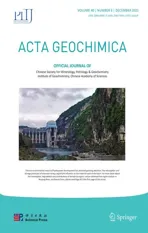Constraints on unconsolidated pyroclastic flow sediments related REE enrichments originated from potassic-alkaline Go¨lcu¨k stratovolcano: Darıdere-Direkli-Yakao¨ren (DDY) table 4deposits,southwestern Anatolia of Turkey
2021-11-04MuratBudakogluAliTugcanUnluerZeynepDonerHuseyinKocaturkMustafaKayaMustafaKumralSezaiKirikoglu
Murat Budakoglu • Ali Tugcan Unluer • Zeynep Doner • Huseyin Kocaturk •Mustafa Kaya • Mustafa Kumral • M. Sezai Kirikoglu
Abstract In the last five decades, Rare Earth Elements(REE) are mostly produced from carbonatite complexes and alkaline magmatic environments. In this respect,pyroclastic flows produced by the potassic-alkaline Go¨lcu¨k volcanism in the Isparta (SW, Turkey) angle stand out as an important target area where REE enrichments can be observed. This study focuses on the REE potential, geochemical and mineralogical characteristics of REE-bearing minerals as well as formation modeling of unconsolidated pyroclastic flows in Darıdere-Direkli-Yakao¨ren (DDY)deposits in Turkey. REE-bearing minerals of DDY deposits which contain abundant trachytic-trachyandesitic rock fragments were determined as fluorapatite, britholite, and chevkinite by using XRD and SEM–EDX analyses.According to the geochemical analysis, the vast majority of ΣREE (up to 996 ppm) content is LREE such as La, Ce and Nd. Darıdere is the most REE enriched region followed by Yakao¨ren and Direkli regions in terms of LREE(574.9 ppm), relative to MREE (38.5 ppm) and HREE(5.28 ppm) contents. These results are also on par with subduction-related Italian extrusive carbonatites such as Polino, Cupaello and San Venenzo. The DDY deposits can also be comparable with intraplate extrusive REE deposits in terms of LREE enrichments, however, HREE, Nb, Th and Zr values are generally lower. The ΣREE concentrations tend to rise with the increasing contents of alkaline elements (Na and K), HFSE (such as Nb and U), as well as LILE (Ba, Sr and Rb) and are negatively affected by sedimentary carbonate involvement. The economic value of the DDY deposits can gain importance due to the increasing global demand for LREE’s.
Keywords Pyroclastic flows ∙Rare Earth Elements(REE) ∙Apatite ∙Britholite ∙Chevkinite ∙Alkaline-Ultrapotasic magmatism
1 Introduction
Rare Earth Elements (REE) are considered critical metals,due to their widespread use in many ‘‘green’’ technologies,such as renewable energy production and distribution,hybrid and electric vehicles, consumer electronics, imaging technologies in healthcare. For this reason, REEs are becoming more attractive commodity targets for the mineral industry. Light REE (LREE; La-Eu: atomic numbers 57 through 63) can be extracted commercially from various geologic environments such as alkaline complexes with carbonatite intrusions, peralkaline magmatic rocks, Iron-Oxide Copper Gold deposits (IOCG) and heavy mineral sand deposits with alteration resistant REE-phosphate minerals (monazite and xenotime). Moreover, some geological occurrences can be considered as a source with a considerable amount of LREE, Th and U content including fluorapatite veins, phosphorites, unconformity-related uranium deposits, lignites and shales. In addition to being present in some LREE sources, examples of heavy REE(HREE; Tb-Lu: atomic numbers 65 through 71) sources include ion adsorption clays (Sanematsu and Watanabe 2016), alumina production waste (Deady et al. 2016), and highly fractionated rhyolites (Jowitt et al. 2017).
The mineralization, concentration and distribution of the REE are influenced by the magmatic and post magmatic events such as fractional crystallization, alkali metasomatism and recurrent hydrothermal activity along with the surficial processes including atmospheric weathering and sedimentation (Le Bas 1981; Andersen 1986;Alberti et al. 1999; Gnandi and Tobschall 2003; Murakami and Ishihara 2008; Kon et al. 2014; Mir 2015; Gong et al.2021). In Turkey, the published data related to REE geochemistry, generally focused on mineralization properties of alkaline-carbonatitic complexes (e.g., Stumpfl and Kırıkog˘lu 1985; Morteani and Satır 1989; O¨ zgenc¸ and Kibici 1994; Gultekin et al. 2003; Nikiforov et al. 2014; Deady et al. 2019; C¸ imen et al. 2020),in-situenrichments of lateritic occurrences (Karadag˘et al. 2009; Deady et al.2016; O¨ ztu¨rk et al. 2019) and seldomly subjected distribution patterns of extreme environment sediments (Budakoglu et al. 2015).
One of the most studied REE rich potassic-alkaline province in Turkey is the Isparta-Afyon-Eskis¸ehir tearing zone (Alıcı et al. 1998; Savas¸c¸ın and Oyman 1998; Francalanci et al. 2000; Dilek and Altunkaynak 2010; Elitok et al. 2010; Prelevic et al. 2012; Karaog˘lu and Helvacı 2014; Prelevic et al. 2015). Lots of extrusive potassic rocks can be observed in Isparta angle which is located in the southern part of this tearing zone (Alıcı et al. 1998; C¸ oban and Flower 2006; Kumral et al. 2006; Elitok et al. 2010;Platevoet et al. 2014; Caran 2016; Elitok 2019). Go¨lcu¨k stratovolcano is a well-known example of these potassic volcanics and is located at the center of the ‘‘Isparta Angle’’. The volcano extruded on a complex pile of allochthonous units which tectonically overlain the relative autochthonous Beydag˘ları platform (Platevoet et al. 2008).In the last two decades, potassic and ultrapotassic volcanism have been widely used to study the eruptive chronology of pyroclastic fragments in various volcanic sequences(Freda 2006; Giaccio et al. 2007; Platevoet et al. 2008).However, REE contents of weathered pyroclastic rocks under subtropical conditions and alteration degrees of highly altered rocks were subjected to limited studies(Malpas et al. 2001; Bu¨chl and Gier 2003). The fly ash placer type REE mineralizations in Turkey have been restricted to the study of the C¸ anakli (Burdur, Turkey)deposit. The deposit has an average grade of 0.08 wt.%ΣREE and identified REE-bearing minerals are allanite,chevkinite, titanite and apatite (Cox and Fayram 2013).Minor amounts of thorium (Th) bearing minerals were also identified such as thorite, uranothorite and betafite (Cox and Fayram 2013). Other fly ash placer type depositions located in Isparta apex are found in C¸ obanisa and Kuyubas¸ı regions (Budakog˘lu et al. 2017; Unluer 2017). Detailed mineralogical and geochemical studies indicated that the most likely source for the C¸ anaklı deposit is the Go¨lcu¨k alkaline volcano which is located 23 km north of the deposit (Deady et al. 2019). Although the entire volcanic history of the Go¨lcu¨k volcano is quite young (Upper Miocene-Pliocene aged), it is characterized by recurrent explosive events and episodically thick, far-traveled ignimbrite units (Platevoet et al. 2008).
During the Upper Miocene-Pliocene period in Isparta(southwestern Anatolia of Turkey), a series of pyroclastic sequences occurred as ignimbritic flows which derived from the flanks of the Go¨lcu¨k caldera (Nemec et al. 1998;Kumral et al. 2006; Platovoet et al. 2008). These ignimbritic flows flew towards the north (Yakao¨ren region)and southeast (Darıdere and Direkli regions) directions. In this study, we characterize these ignimbritic sequences as Darıdere-Direkli-Yakao¨ren (DDY) deposits for the first time and help to understand the REE enrichment mechanism related to the extrusive peralkaline system which is relatively rare when compared to the REE-rich intrusive peralkaline rocks. The deposits are described as unconsolidated pyroclastic flow material with abundant ferromagnesian and mica minerals accompanied by Caplagioclase microlites and volcanic glass.
The main objective of this work is to reveal the REE potential of unconsolidated pyroclastic flows in DDY deposits which are located around the Go¨lcu¨k caldera(southwestern of Isparta, Turkey) and analogise the similarities between the extrusive products of Late Pleistocene Italian (Umbria Latium area, Italy) carbonatites. Comparisons between DDY and other extrusive REE deposits which formed under intraplate magmatic conditions such as Peak Range, Toongi, Brockman (Australia), Foxtrot(Canada) and Round Top (USA) were also made. In addition, some specific REE elements (Y, Sm, Pr, Gd and Nd) of the DDY deposits were compared and coherence examined with different types of systems like alkalinecarbonatite complexes, peralkaline and peraluminous rocks to reveal the economic vector of such occurrences. For this purpose, (1) REE and trace element contents of DDY pyroclastic flows were determined and the REE-bearing minerals were identified by obtained mineral geochemistry data. (2) Geochemical and mineralogical characteristics and formation modeling of DDY deposits were revealed.(3) REE potential of DDY deposit were compared with Italian carbonatites with similar geological properties such as Cupaello (Stoppa and Cundari 1995; Stoppa and Woolley 1997), Polino and San Venenzo volcanoes(Stoppa and Woolley 1997). (4) Geochemical features of DDY deposits also compared with intraplate magmatism related extrusive REE deposits (Foxtrot, Toongi ore, Round Top rhyolite, Peak Range volcanics, Brockman Nb-Tuff)for better understanding the REE and other incompatible element enrichments. (5) Some typical REE-deposits and mineralization fields in China (Bayan Obo), Brazil (Barra do Itapirapua˜), Texas (Sierra Blanca), Italy (Pianciano,Ficoreto, Forcinella), Australia (Toongi), and Canada(Foxtrot) have been economically compared with DDY deposits.
2 Geological setting
During the Tertiary period, a widespread magmatic activity took place in Western Anatolia (e.g., Dilek and Altunkaynak 2009, 2010; Ersoy et al. 2010). This magmatism was spatiotemporally associated with the Late Cretaceous-Cenozoic convergence of Africa-derived terrains with Eurasia which resulted in the progressive closure of oceanic basins and a series of collisional events (Akal et al. 2013). This widespread magmatism led to a series of acidic to intermediate granitoids and their extrusive counterparts in the NW part of Western Anatolia. (Aldanmaz et al. 2000; Altunkaynak and Dilek 2006; Altunkaynak and Genc¸ 2008; Karacık et al. 2008; Altunkaynak et al. 2012;Ersoy et al. 2012). On the other hand, the magmatism on the E-SE part of the Western Anatolia gave rise to various types of potassic and ultrapotassic volcanic rocks (Savas¸c¸ın and Oyman 1998; Aldanmaz et al. 2000; C¸ oban and Flower 2006; Kumral et al. 2006).
The Go¨lcu¨k volcanics are products of post-collisional alkali-potassic to ultrapotasic magmatism, which has been active in a ‘‘tearing zone’’ since Miocene from Eskis¸ehir-Afyon to Isparta district (Glover and Robertson 1998;Fig. 2). These volcanic rocks in the tearing zone are products of complex tectonics of extension, subduction,collision, carbonate metasomatizm and astenosperic upwelling. The ultrapotassic affinity of the volcanic rocks increases towards the south (Dilek and Altunkaynak 2010).Isparta angle rocks, Go¨lcu¨k intra-caldera and extra-caldera volcanics, subvolcanic lamproites and tephri-phonolites which are located at the southern part of the tearing zone have a significant ultrapotassic character and are enriched by incompatible elements including LREE, Ba and Sr(Kumral et al. 2006). The basement rocks of the region are Beydag˘ları autochthon consisting of Middle-Upper Triassic Kuyubas¸ı dolomite, Jurassic-Cretaceous neritic and pelagic limestones, mostly deposited in a shelf environment. All these units were tectonically overlain by slices of Antalya nappes (Lefevre 1967). The pyroclastic flows originating from the Pliocene Go¨lcu¨k volcano covered all of these units (Francalanci et al. 2000; Fig. 2). A variety of potassic-ultrapotassic lavas and pyroclastic flows were identified in the caldera of the Go¨lcu¨k stratovolcano, such as trachyandesite, trachyte, tephriphonolite and ignimbritic tuff(Alıcı et al. 1998; Kumral et al. 2006; Platevoet et al. 2008;Figs. 1–2).
The Go¨lcu¨k rocks formed during three main eruption stages which occurred in the Go¨lcu¨k caldera (Kumral et al.2006). At the first stage two series of trachytes (augitebearing and porphyritic trachytes) and ignimbritic tuff deposits formed (Alıcı et al. 1998; Kumral et al. 2006). The second stage consists of tephriphonolite lava dome flows which extruded through the caldera and are located along the edge of the crater (Kumral et al. 2006; Platevoet et al.2008). The last stage is represented by tuff ring deposits associated with various freatoplinian eruptions of a maartype volcanic activity (Platevoet et al. 2008). The general view of the sampling region for studied samples is shown in Fig. 3.
3 Samples and analytical methods
A total of 15 samples were collected for the analyses from the DDY pyroclastic flow deposits (Fig. 3). Whole-rock(major, trace and rare earth elements) analyses were conducted on powders grounded using an agate mortar muller milling device in Geochemistry Research Laboratories of Istanbul Technical University (ITU/JAL), Turkey. The oxides of major elements, including SiO2, Al2O3, CaO,K2O, Na2O, Fe2O3, MnO, MgO, TiO2, and P2O5were determined by a Bruker S8 Tiger X-ray fluorescence (XRF)spectrometer with wavelength ranges from 0.01 to 12 nm,the analytical uncertainty is usually <5%.
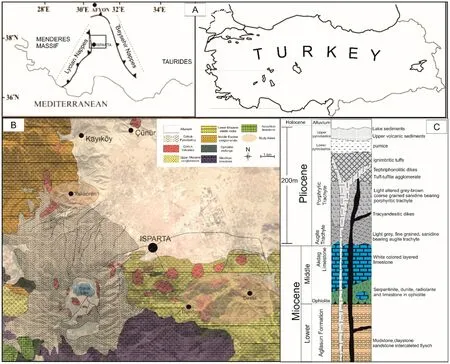
Fig. 1 a Location map, b Geological map ( modified from Caran 2016), c Stratigraphic column section (modified from Kumral et al. 2006), of the study area
Elan DRC-e Perkin Elmer Inductively Coupled Plasma-Mass Spectrometry (ICP-MS) was used for REE and trace element analyses. The materials were all analytical-grade certified for impurities. Pure water was obtained with Zeneer UP 900 model water purification system. The maximum resistivity of pure water was 18.3 MΩcm.Hoechst wax C micropowder, Hydrochloric acid (HCL 37%, w/v), nitric acid (HNO365%, w/v), hydrofluoric acid(HF 38–40%, w/v) and boric acid were supplied by Merck.The mix standard solution; Y, La, Ce, Pr, Nd, Sm, Eu, Gd,Tb, Dy, Ho, Er, Tm, Yb, Lu, Th, U and as an internal standard 1000 μg mL-1of Re were supplied by PerkinElmer. The certified reference material; Andesite AGV-2 was supplied from United States Geological Survey(USGS). A two-step digestion process used approximately 50 mg of powdered samples: (1) 6 mL of 37% HCl, 2 mL of 65% HNO3and 1 mL of 38–40% HF acid mixer put in a pressure- and temperature-controlled Teflon beaker using a Berghoff Microwave at 135 °C; (2) 6 mL of 5% boric acid solution was added to the step one mixer for ICP-MS analyses. the analytical uncertainty is usually <2%.
To obtain REE-bearing minerals for more precise mineralogical determinations, a series of ore enrichment procedures including gravity separation and flotation methods were carried out in Mineral Processing Laboratories of Istanbul University- Cerrahpasa, Turkey. In -250 + 38 μm grain size samples, the gravity separation process was applied with a shaking table and coarse enrichment,sweeping and cleaning processes were applied under the conditions of 6–8-10° table inclination, 340–400-460 rpm stroke speed and 8–10 L/min operating parameters.A Denver D-12 flotation device with related reagents(benzohydroxamic acid) and conditioning parameters was used to obtain a better grade REE-mineral flotation concentrate.
The rock-forming minerals were determined by Leica DM4500P compound microscope and the heavy minerals(in %) determinations Nikon SMZ 800 N model binocular microscope was used in Geochemistry Research Laboratories of Istanbul Technical University (ITU/JAL). The REE-bearing minerals were carried out using a JEOLTMNeoScope JCM6000 Plus scanning electron microscope(SEM–EDX, operated at 15 kV) in Electron microscopy Laboratory of Istanbul Technical University, Department of Metallurgical and Materials Engineering, Turkey. During SEM–EDX analysis, powder samples were directly attached to the top surface of a carbon conductive tape(Ted PellaTM).
X-ray diffraction patterns were studied using Bruker D8 Advance X-ray diffractometer (XRD) (40 kV, 40 mA),which is equipped with Cu X-ray source and wavelength 1.5406 A˚ in Geochemistry Research Laboratories of Istanbul Technical University (ITU/JAL). Radiation scanning in the range of 2°–72° for each interval of 0.02 and 5°/min.
4 Results and discussion
4.1 Mineralogical and petrographical characteristics of DDY deposits
The pyroclastic flows in the DDY deposits are generally unlithified or unconsolidated and rarely contain pebblesized volcanic fragments. According to polarized microscope studies, these volcanic fragments were defined as trachyandesite and trachyte. Trachyandesites generally show a hyalo-porphyritic texture and major minerals are plagioclase and K-feldspar phenocrystals with subhedral shapes. Sericitization and clayization are common in the crystal borders of these minerals. Strong pleochroism is observed in mica minerals (Fig. 4a–c). Similar to the trachyandesites, trachytes are also hyalo-porphyric in texture and consist of approximately equal proportions of glass and plagioclase microliths. However, unlike trachyandesite,euhedral clinopyroxenes and anorthite minerals are common in trachyte (Figs. 4d–f).
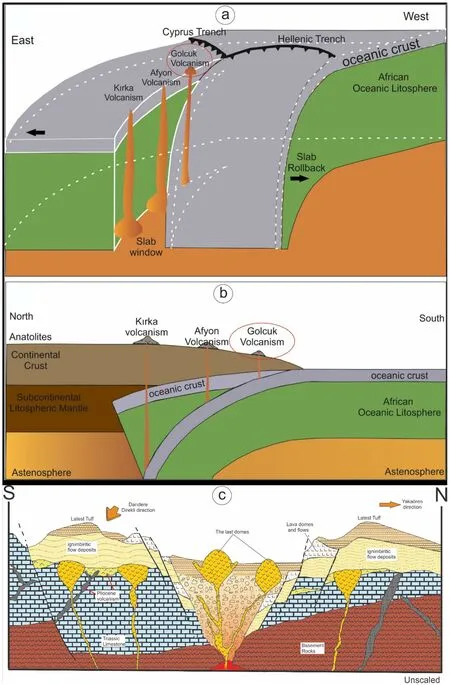
Fig. 2 A geodynamic model for the evolution of the a East–West and b North– South-trending potassic-alkaline volcanics ( modified from Dilek and Altunkaynak 2009), c the schematic cross section of Go¨lcu¨k stratovolcano and pyroclastic flow movement, indicating the formation modeling (modified from Platevoet et al. 2008)
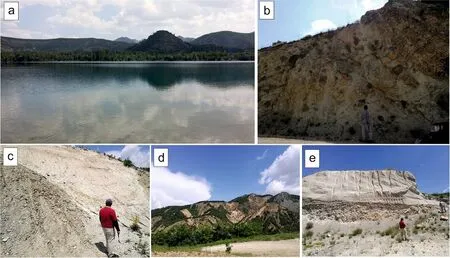
Fig. 3 General view of sampling region for studied samples, a Go¨lcu¨k volcano, b Darıdere region, c Direkli region, d Pyroclastic flow,e Yakao¨ren region
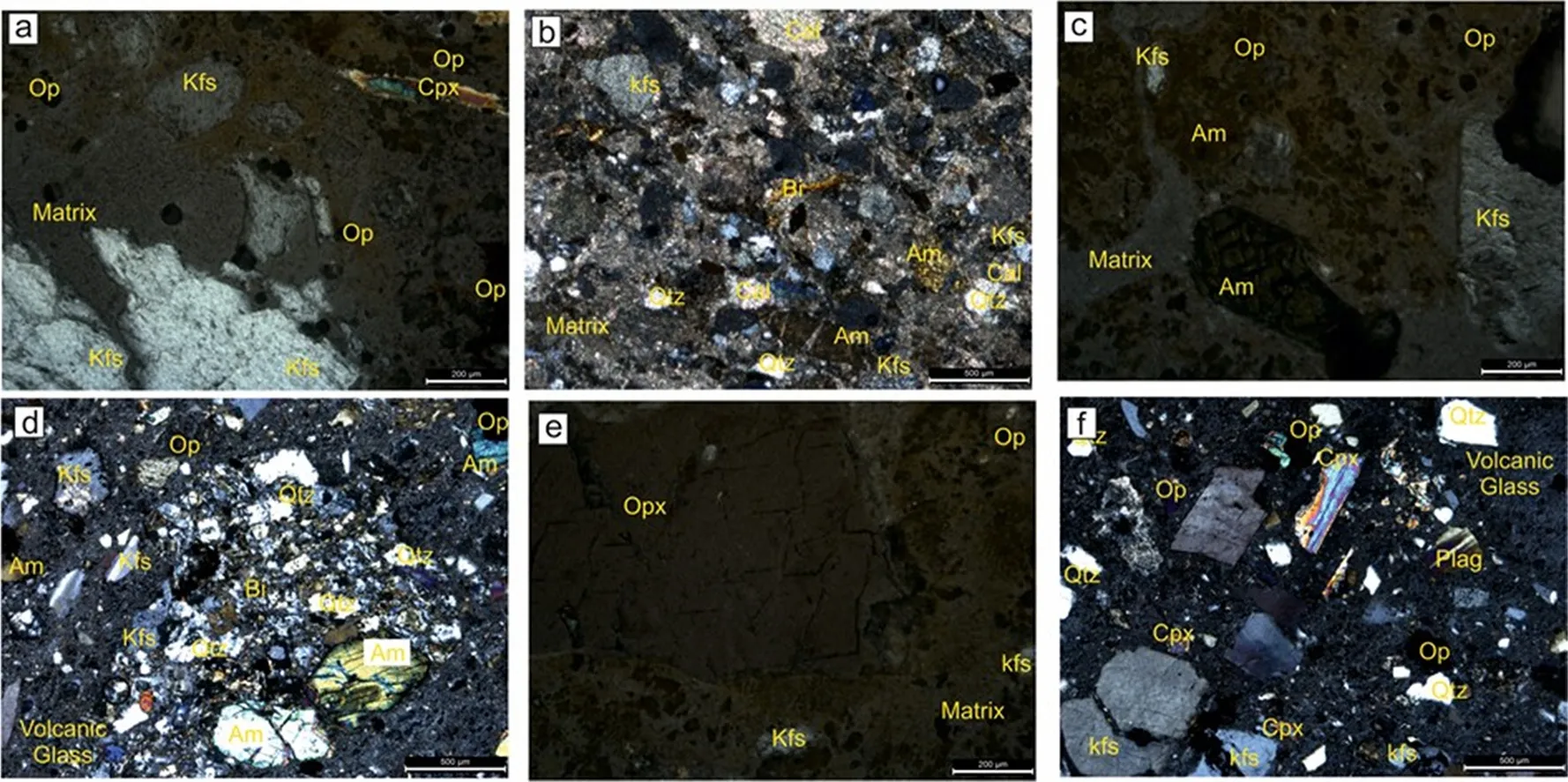
Fig. 4 Photomicrographs of the mineral assemblages of trachyandesite (a,b,c) and trachyte (d, e, f). in the DDY deposits. Abbreviations:Amphibole (Am), biotite (Bi), Clinopyroxene (Cpx), K-feldspar (Kfs), ortopyroxene (Op), Plagioclase (Plag), quartz (Qtz)
The mineral composition of the analysed samples is coherent with the heavy mineral composition of the pyroclastic flows of Go¨lcu¨k stratovolcano (Kumral 2006). The heavy mineral concentrates mainly consist of amphibole,apatite, zircon and titanite and minor amounts of feldspar and calcite (Fig. 5).
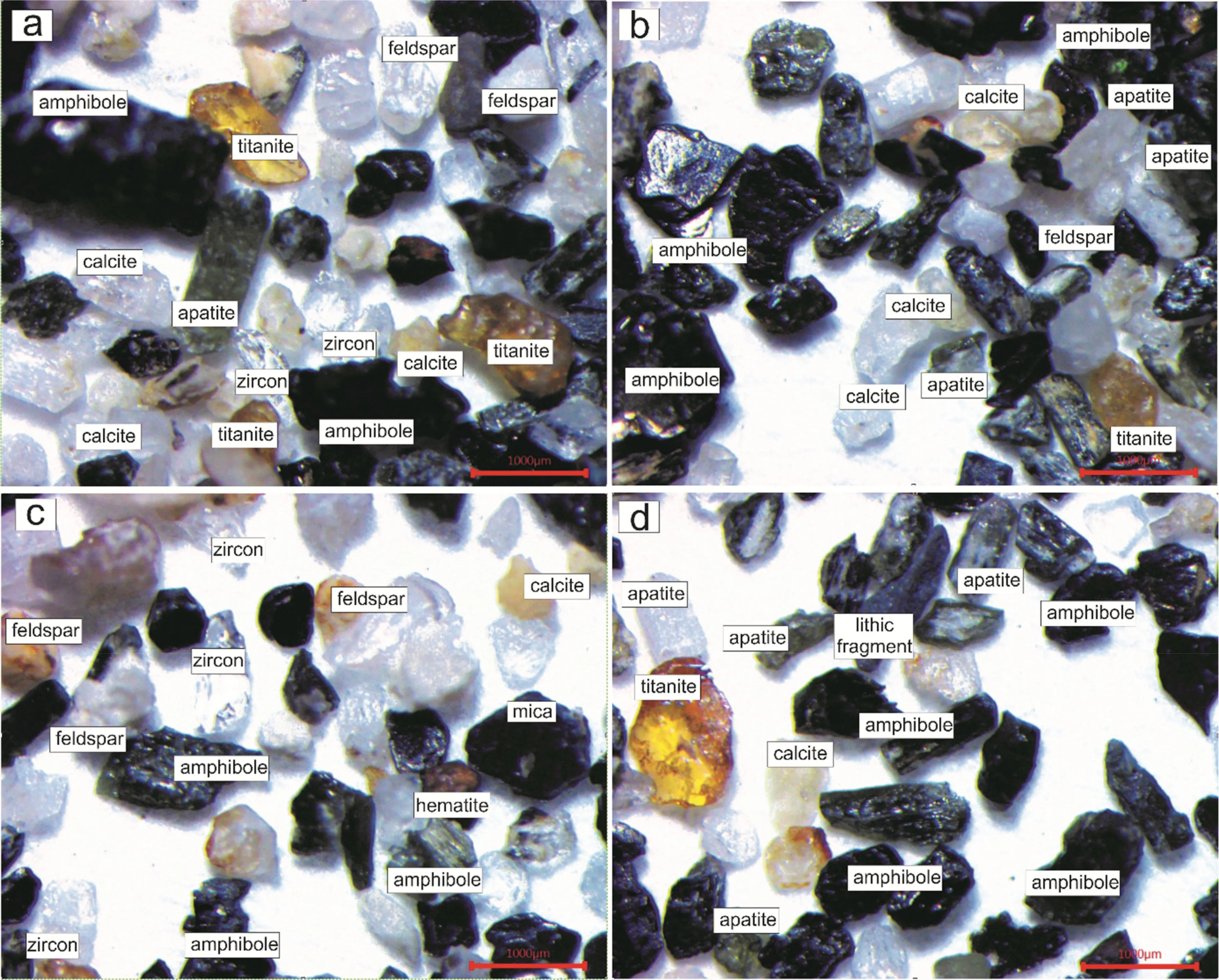
Fig. 5 Binocular microscope photomicrographs of heavy minerals selected from Darıdere (a-b), Direkli (c) and Yakao¨ren samples
4.1.1 XRD analyses
Initial XRD analyzes were performed for bulk unlithified pyroclastic samples to determine the mineral paragenesis of the deposits (Fig. 6). In addition to mica and quartz which remain stable in atmospheric conditions, less resistant feldspar was observed. The absence of any REEbearing minerals other than these silicate minerals suggests that REE can be associated with layered silicates or smaller grain size ore minerals (Fig. 6).
XRD analyzes were conducted on the enriched mineral concentrates which obtained from bulk pyroclastic material(by using gravity separation and flotation methods) to determine their REE mineral assemblages (Fig. 6). XRD patterns of mineral concentrates indicate the existence of REE-bearing fluorapatite and britholite. Determination of britholite with XRD analysis in the mineral concentrates indicates that these minerals are not entirely amorphous form and their crystal structure are not disrupted by radiation from contained or nearby radioactive atoms.
The ideal composition of apatite, calciobritholite and britholite series are represented by flourapatite fluoracalciobritolite and fluorobritholite (Fig. 7). REE-bearing phosphate minerals such as monazite, xenotime and britholite are the most naturally abundant forms that are associated with fluorapatite. In the case of fluorapatite or chlorapatite structure, while the LREE mainly substitute on the Ca (1) site (ninefold coordination), the (Y + HREE)prefer the Ca (2) site (sevenfold coordination) (Hughes et al. 1991; Fleet and Pan 1995, 1997; Pasero et al. 2010).
4.1.2 SEM–EDX analyses
SEM–EDX studies determined chevkinite and britholite minerals grew over the titanite, apatite and feldspar surface(Figs. 8a–c). SEM–EDX results on individual apatite also indicate that these euhedral apatite crystals contain significant amounts of REE. The elemental composition of these apatites indicates that it may be named carbonate hydroxyapatite (Ca5(PO4, CO3)3(OH) (Fig. 8d). The REE enrichments in britholite and chevkinite probably indicate the metasomatic evolution of these apatite minerals. In other words, chevkinite and britholite minerals are formed from apatite minerals which react with H2O and CO2-rich hydrothermal fluids. Moreover, apatite minerals with different compositions can be formed by fluid mineral interaction which took place on primary apatite crystals.
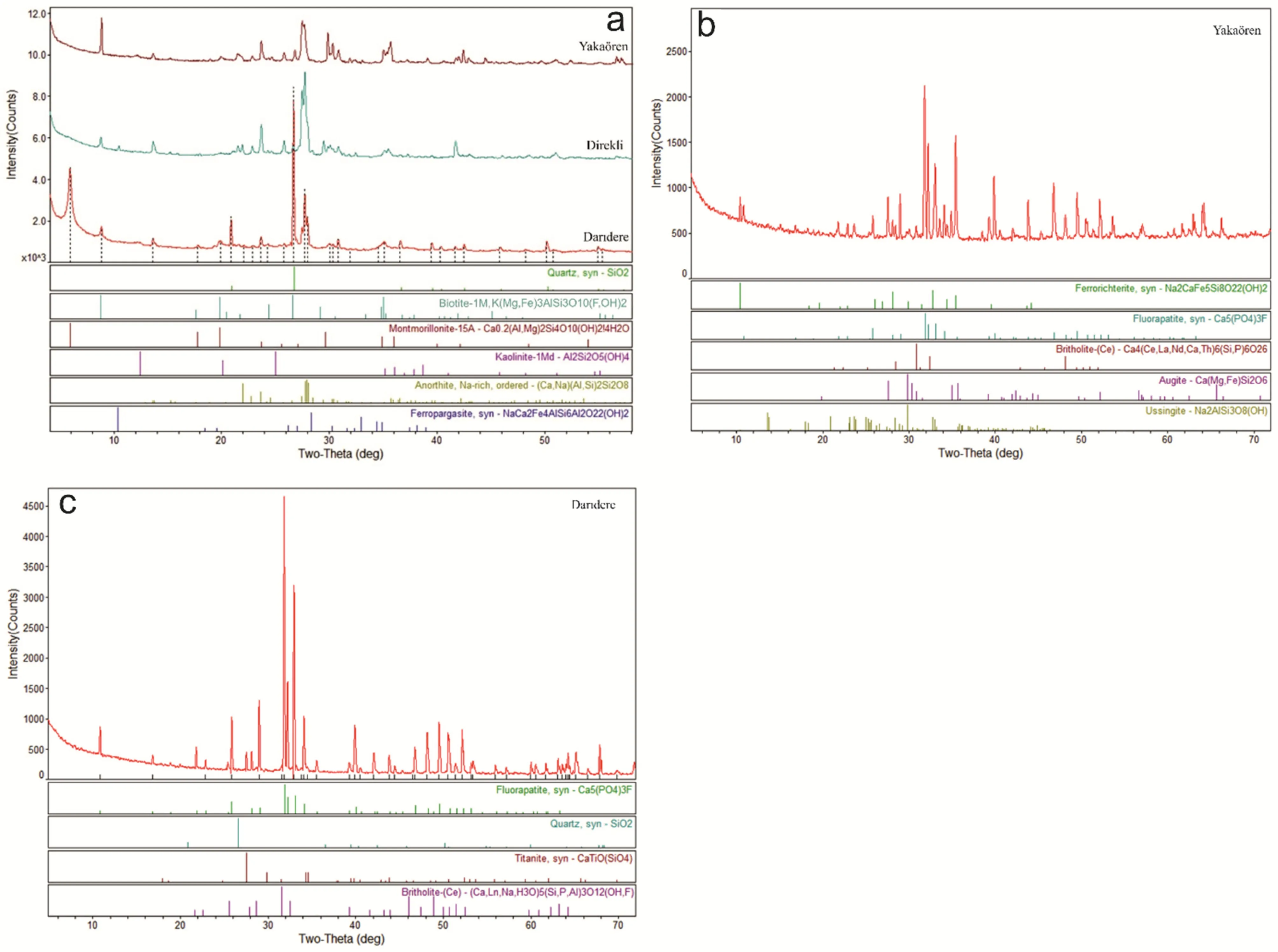
Fig. 6 a X-Ray diffractograms of selected Darıdere-Direkli-Yakao¨ren samples, b-c X-Ray diffractogram of enriched concentrates from Darıdere and Yakao¨ren samples
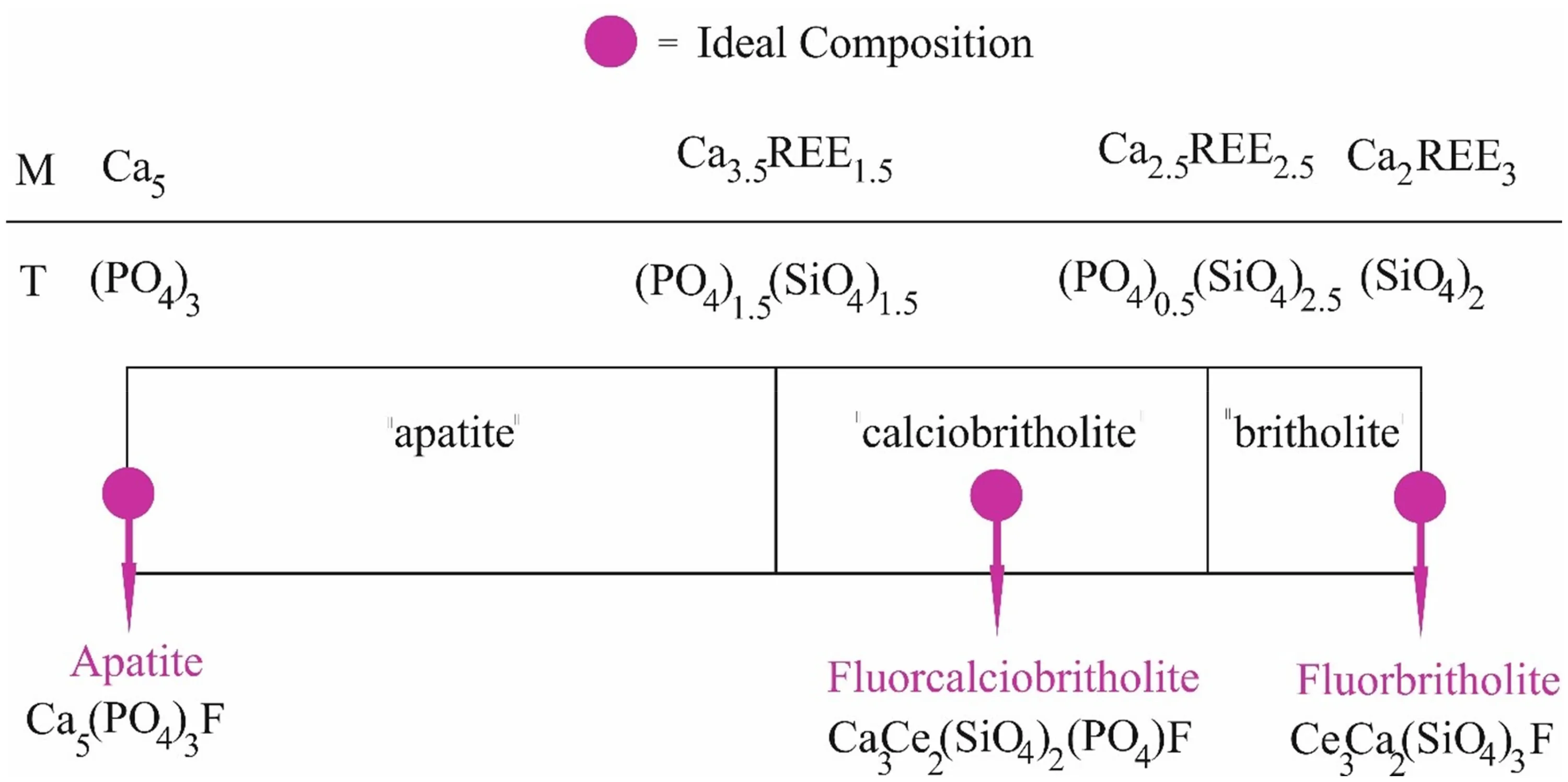
Fig. 7 Substitutions at the M and T sites in the series apatite –calciobritholite – britholite (modified from Pasero et al.2010)
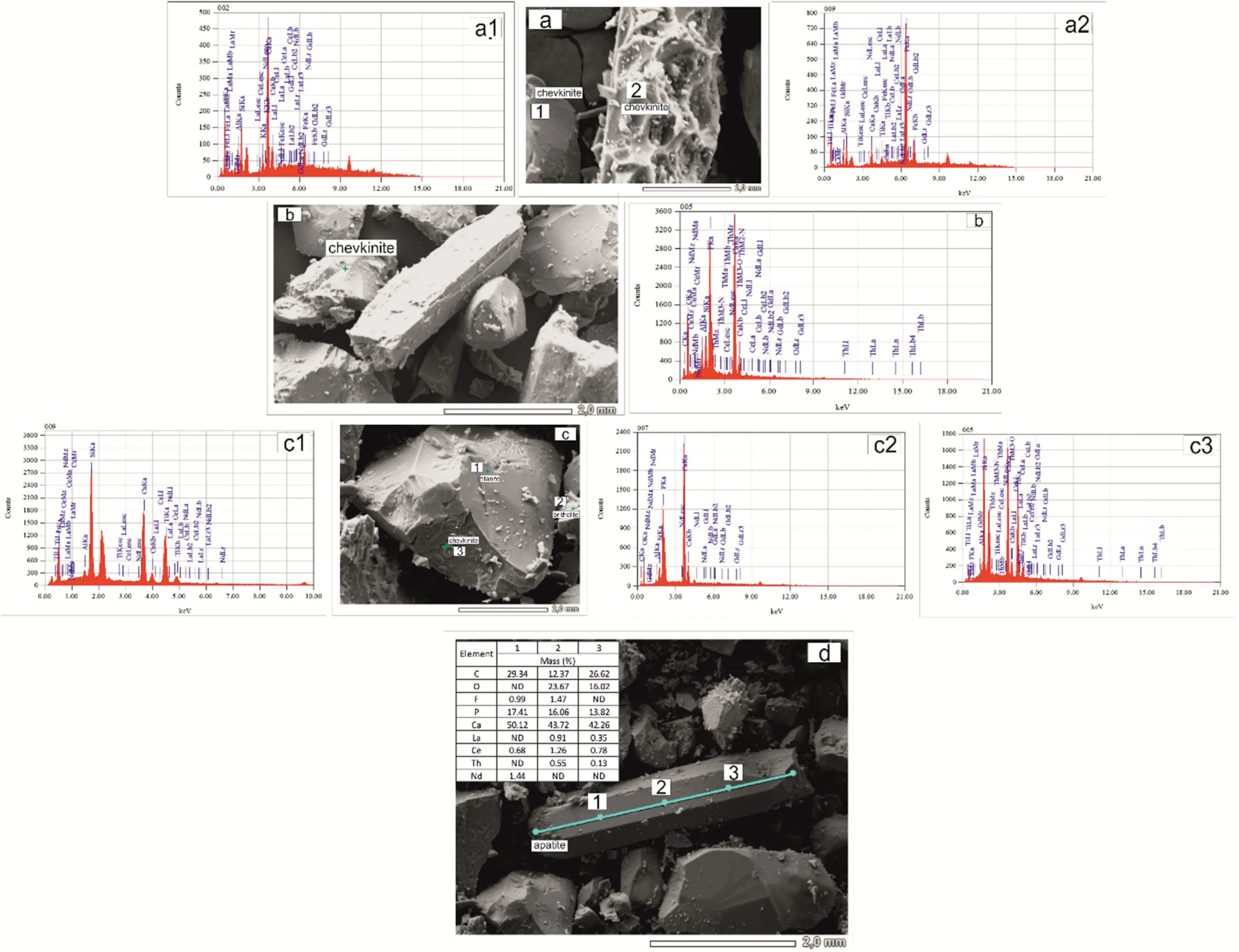
Fig. 8 EM images of chevkenite (a–b), titanite and britholite (c), REE-bearing apatite mineral (d) in DDY mineral concentrate
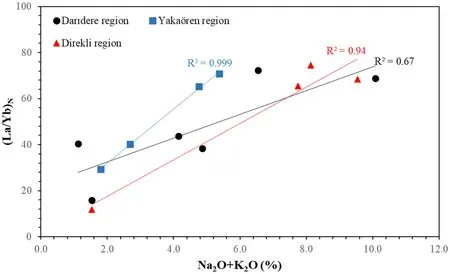
Fig. 9 Plots of (La/Yb)N vs.Na2O + K2O (%) for Darıdere,Direkli, and Yakao¨ren regions
REE-bearing minerals including chevkinite (Ti-bearing)and britholite were observed with increasing content of La,Ce, Nd, Gd (up to 15 wt.%). Chevkinite and britholite were determined in whole DDY samples. The existence of these minerals is quite compatible with mineral paragenesis of C¸ anaklı deposits (Cox and Fayram 2013; Deady et al.2016). The mineral chevkinite forms mainly in highly fractioned rocks such as rhyolites and alkaline-potassic rock parageneses, such as syenites, nepheline syenites and fenites associated with carbonatite complexes (MacDonald and Belkin 2002). Chevkinite contains different amounts of REE due to a variety of elemental substitutions. On the other hand, britholite mineralization on DDY deposits is probably related to late magmatic, high fluorine and CO2fluids interacting with earlier apatite crystals. According to Pasero et al. (2010), it is typically Th-bearing and metamict with the formula of (REE,Ca)5[(Si,P)O4]3(OH,F) or, in simplified form, (Ce,Ca)5(SiO4)3(OH).
4.2 Geochemical signatures
The whole-rock geochemistry handled by XRF and ICPMS which is consistent with field observation and determined petrographic characteristics supports our classification of pyroclastic settlement in the three adjacent areas.Representative geochemical analyses of major, trace and REE abundances of DDY pyroclastic flow sediments are listed in Tables 1, 2 and 3. While XRF results of bulk pyroclastic samples present important information on the major oxide of DDY deposits, ICP-MS results enumerate sensitive results of REE and trace element contents.
Min–Max wt.% values of major elements for the studied eleven samples collected from DDY deposits (Table 1)show that SiO2is the dominant oxide (11.0–64.9 wt.%),followed by Al2O3(4.51–27.6 wt.%), Fe2O3(1.08–23.7 wt.%), and CaO (1.54–46.3 wt.%). Increased CaO contents of alkali-rich samples with high ΣREE values were interpreted as the contribution of carbonate-rich melts to the magma chamber (Caran 2016). However, some carbonaterich samples with low ΣREE values (samples of DRDY-3,DRDY-4 and DRK-1) indicating the sedimentary carbonate clastics’ involvement in volcanic flows (Table 3).
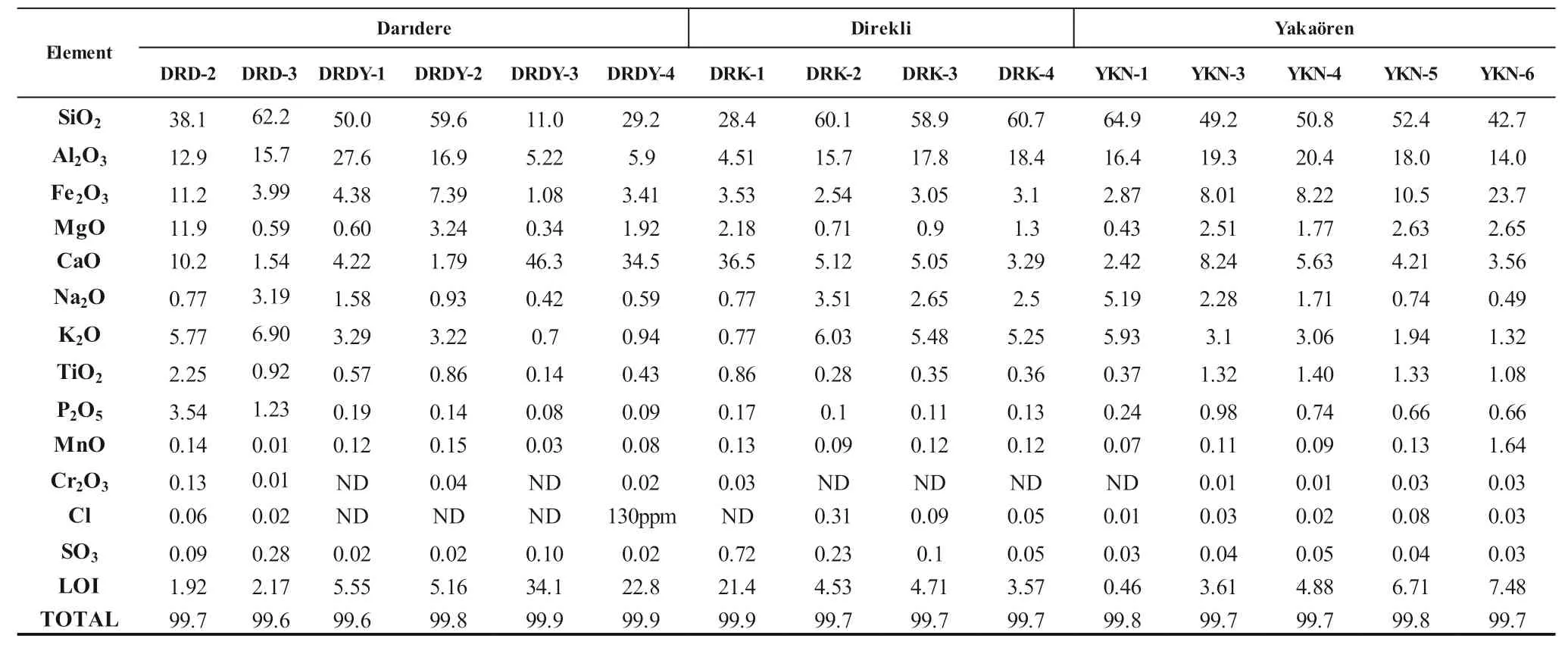
Table 1 Contents of the DDY deposits (in wt.%)
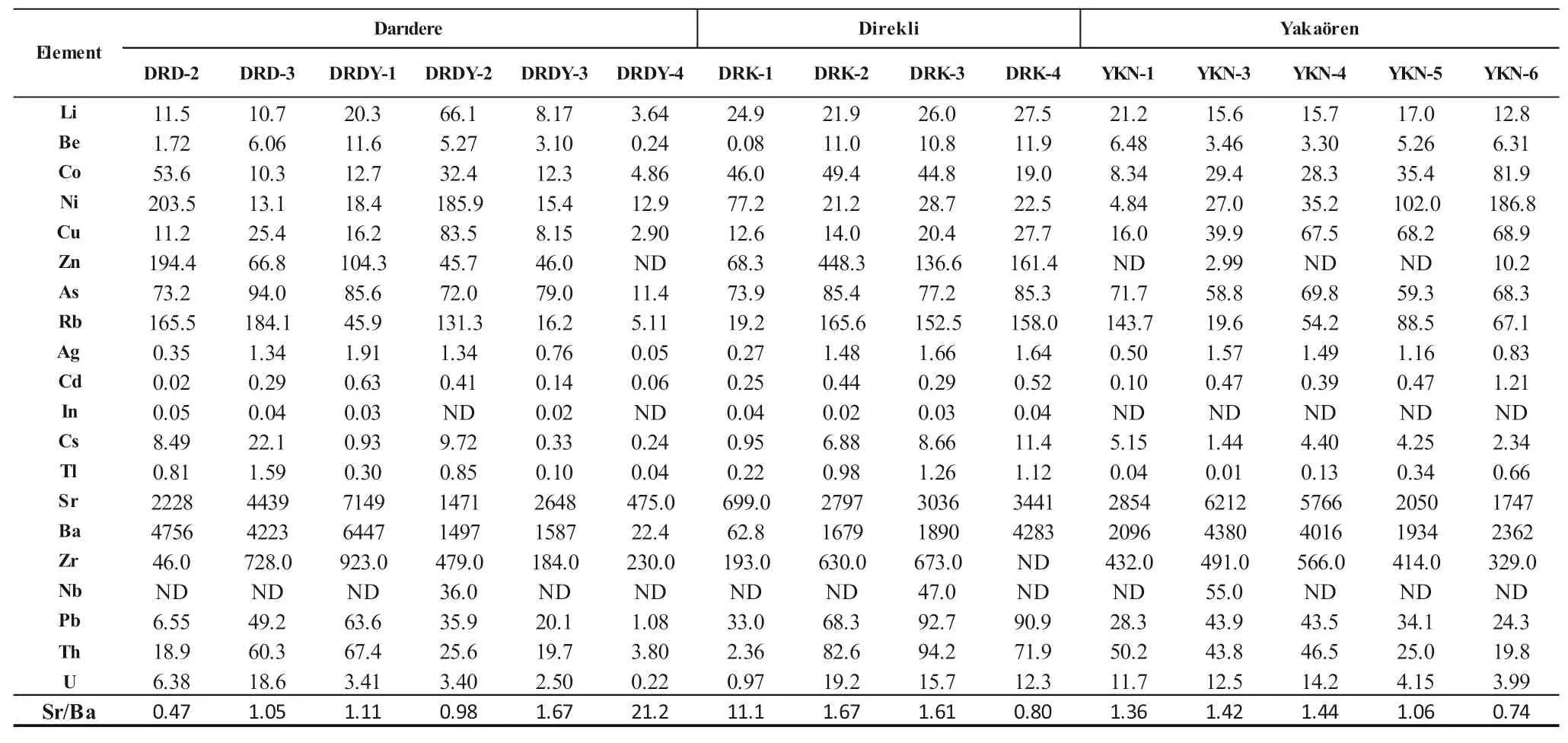
Table 2 Trace element data (contents in ppm) and Sr/Ba ratios for DDY deposits
Concentrations of Na2O (range from 0.42 to 5.19 wt.%),TiO2(0.14–2.25 wt.%) and K2O (0.70–6.90 wt.%) are moderate to high and MnO (0.01–1.64 wt.%) values are generally low. With the exception of sample DRD-2, P2O5contents range from 0.08 to1.23 wt.%, which is reflected in the restricted modal abundance of apatite. The sample DRD-2 has higher content (3.54 wt.%) of P2O5mainly caused by REE-bearing apatite group minerals.
Consistent with the volcanic origin both Sr (up to 7149 ppm) and Ba (up to 6447 ppm) contents are high, and the Ba/Sr ratio varies from 0.37 to 2.13. This range is compatible with the transition of pyroclastics between the trachyte andesite and trachyte. However, Sr values of samples especially DRDY-4 and DRK-1 were also depleted according to the other pyroclastic samples (Table 2).According to Elitok et al. (2010), the87Sr/86Sr ratios of Srrich (Sr up to 7000 ppm) Go¨lcu¨k volcano also indicate that crustal contamination was significant for the evolved extracaldera volcanics, but was negligible for the intracaldera volcanics. The crustal contamination is also noticeable in all DDY samples, which can be classified as extracaldera volcanics in terms of the geochemical properties.
Ba, Sr, and Pb enrichment in all DDY samples indicates that the involvement of crustal rocks took place in the subduction process which led to the formation of the Go¨lcu¨k magma chamber. The extreme variations in other trace elements are possibly controlled by the uneven distribution of silicate and heavy mineral contents in pyroclastic flows (Table 2). Some Ag-As enrichments can be interpreted as a metasomatism process that has been active in Go¨lcu¨k caldera and nearby units (Kus¸c¸u 1995; Kus¸c¸u and Abdullah 2017).
The REE results and important ratios for DDY deposits are present in Table 3. While ΣREE content is relatively high (range from 81 to 996 with an average of 619 ppm)for all DDY samples, it has slightly higher ΣREE values at Yakao¨ren and Direkli regions. Despite the Yakao¨ren region is closer to the caldera, the paleomorphology of the study area helped the movement of ignimbiritic flow to the southeast direction, resulting in the denser minerals enriching in the Darıdere region (Table 3). In addition,according to the comparison of the concentration variations of light REE (LREE; La–Nd), middle REE (MREE; Sm–Ho) and heavy REE (HREE; Er–Lu), DDY samples are enriched with ΣLREE, relative to ΣMREE and ΣHREE,with 574.9, 38.5 and 5.28 ppm, respectively.
Calculated chondrite-normalized (Boynton 1984)LREE/HREE (La/Yb)Nvalues indicated that there is a wide range of LREE to HREE ratios for the Darıdere,Direkli, and Yakao¨ren deposits with the min and max values of 15.8–72.2, 11.9–74.5, 29.4–70.8, respectively(Table 3). The most likely cause for these variations is the involvement of different magmatic rocks located in Go¨lcu¨k caldera. The higher values of incompatible trace elements with enrichment of K, Rb, Ba, Sr, LREE, Ti, Nb, Zr refer to a metasomatized mantle source for the volcanic origin(Table 2). In addition, the LREE/MREE (La/Sm)Nvalues show close range, varying from 4.70–8.37, 3.53–12.0 and 4.41–7.48 for Darıdere, Direkli and Yakao¨ren samples,respectively (Table 2). Similarly, there is a narrow range of chondrite-normalized (Boynton 1984) MREE/HREE (Gd/Yb)Nvalues for Darıdere, Direkli and Yakao¨ren samples,ranging from 2.57–8.47, 2.68–4.70, and 4.28–6.92,respectively.
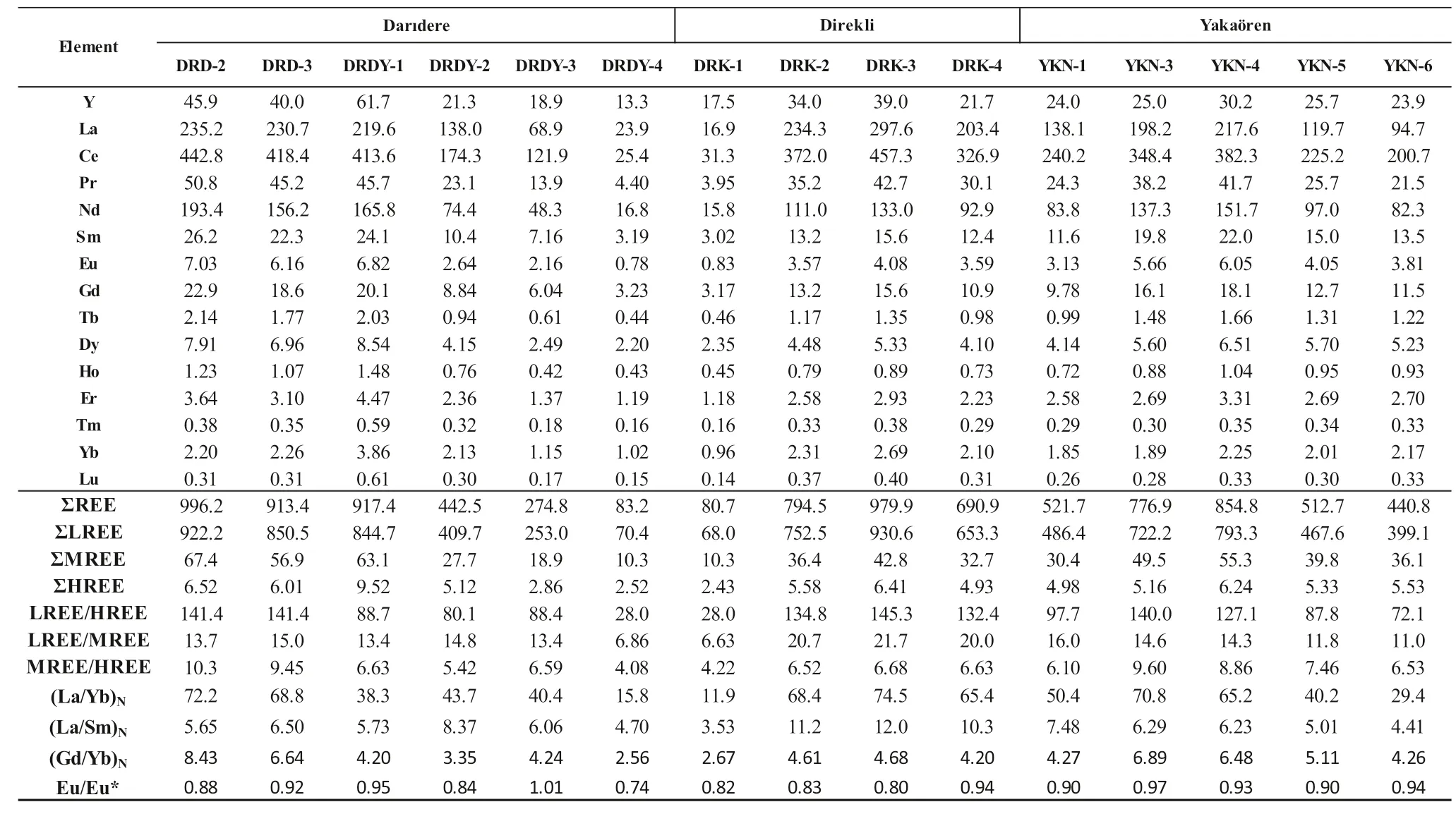
Table 3 The rare earth elements (REE) results and important ratios for DDY deposits (contents in ppm)
The positive correlation between (La/Yb)Nand alkaline elements (Na2O + K2O) is closely related to increasing incompatible behavior of the LREE in low silica, potassic magma evolution in subduction-related volcanic arcs(Fig. 9). The strong positive correlation of SiO2vs. (La/Yb)Nand (La/Sm)N(r = 0.98 and 0.97;p-value = 0.02 and 0.03, respectively) for Direkli samples indicate that the contribution of Ca-Mg rich rock fragments to the Direkli pyroclastics contrary to primary potassic rock fragments. In addition, the positive correlation is present between SiO2vs. (La/Sm)N(r = 0.55 and 0.83;p-value = 0.26 and 0.08),while there is a weak correlation between SiO2and (La/Yb)Nfor Darıdere and Yakao¨ren samples (Fig. 10;Table 4). These results are primarily related to highly evolved volcanic rocks with alkaline affinity generally have lower amounts of HREE caused by lack of garnet group minerals (Bea 1996). The slight MREE enrichment in DDY samples possibly hosted by amphibole group(Dessimoz et al. 2012) minerals that can be found in trachyandesitic rocks of Go¨lcu¨k caldera (Alıcı et al. 1998;Kumral 2006). The strong positive correlation of SiO2vs.(Gd/Yb)Nfor Direkli samples (r = 0.96;p-value = 0.04)with lack of correlation for Darıdere and Yakao¨ren samples support this conclusion as well (Table 4; Fig. 10).
Moreover, there is a negative correlation between CaO vs. (La/Yb)Nand (Gd/Yb)Nfor Darıdere and Direkli samples (r = -0.54 and -0.59; r = -0.37 and -0.48, respectively, Figs. 10–11; Table 4) showing the presence of sedimentary carbonates in these samples. However,increasing CaO content is associated with an increase in(La/Yb)Nand (Gd/Yb)Nrates especially for Yakao¨ren samples (r = 0.75 and 0.93; p-value = 0.10 and 0.02,respectively; Figs. 10–11, Table 4). This result may reflect the elevated concentration of the CaO-bearing apatite and CaO and SiO2-enriched britholite chevkinite mineralization for Yakao¨ren samples. Although all DDY samples contain these REE-bearing minerals, these geochemical effects are only noticeable in the Yakao¨ren region. It can be concluded that the Yakao¨ren samples contain a minimal amount of fragments from sedimentary carbonate rocks. The Ca content is thought to be originating from the magma chamber of Go¨lcu¨k volcano and points out likely carbonate metasomatism in earlier REE-bearing minerals. The good negative correlation between CaO vs. (La/Sm)Nfor Darıdere and Direkli samples (r = -0.49 and -0.55) and lack of the correlation for Yakao¨ren samples also support sedimentary carbonate involvement for Darıdere and Direkli samples.
In Fig. 10, the plots of P2O5vs (La/Yb)Nand (La/Sm)Nand (Gd/Yb)Nfor Direkli samples show the negative correlation (r = -0.60, -0.59, -0.53; Table 4. While there is a weak correlation between P2O5vs (La/Yb)Nand (La/Sm)N(r = 0.41 and -0.41), a strong positive correlation observed between P2O5vs. (Gd/Yb)N(r = 0.78;p-value = 0.10) in Yakao¨ren samples. On the contrary,Darıdere samples show a strong positive correlation between P2O5and (La/Yb)Nand (Gd/Yb)N(r = 0.78 and 0.92; p-value = 0.07 and 0.009), with a lack of correlation for (La/Sm)N, suggesting that apatite exerts an important role in controlling LREE/HREE and MREE/HREE distributions in these samples. The higher content of P2O5(up to 3.54 wt.%) for Darıdere samples supports this conclusion(Figs. 10–11; Tables 3–4.
In addition, the ultrapotassic rocks with negative Eu anomaly possibly evolved from an Eu depleted residue,although some of the Go¨lcu¨k related potassic rocks show a slight positive Eu anomaly (Dilek and Altunkaynak 2010).Negative Eu anomalies are also observed in DDY deposits,therefore it can be concluded that DDY deposits predominantly are originating from an Eu depleted magma source.As shown in Fig. 11, there are weak correlations between Eu/Eu* vs. SiO2, CaO and P2O5for Darıdere and Direkli samples, for Yakao¨ren samples the strong positive correlations are observed with CaO and P2O5(r = 0.81 and 0.80;p-value = 0.10 and 0.10; Table 4) and negative correlation with SiO2(r =-0.63; Table 4). These results indicate that Darıdere and Direkli samples contain a minor amount of Eu-bearing feldspars which were crystallized from a less fractioned magma source (Nagasawa 1973).
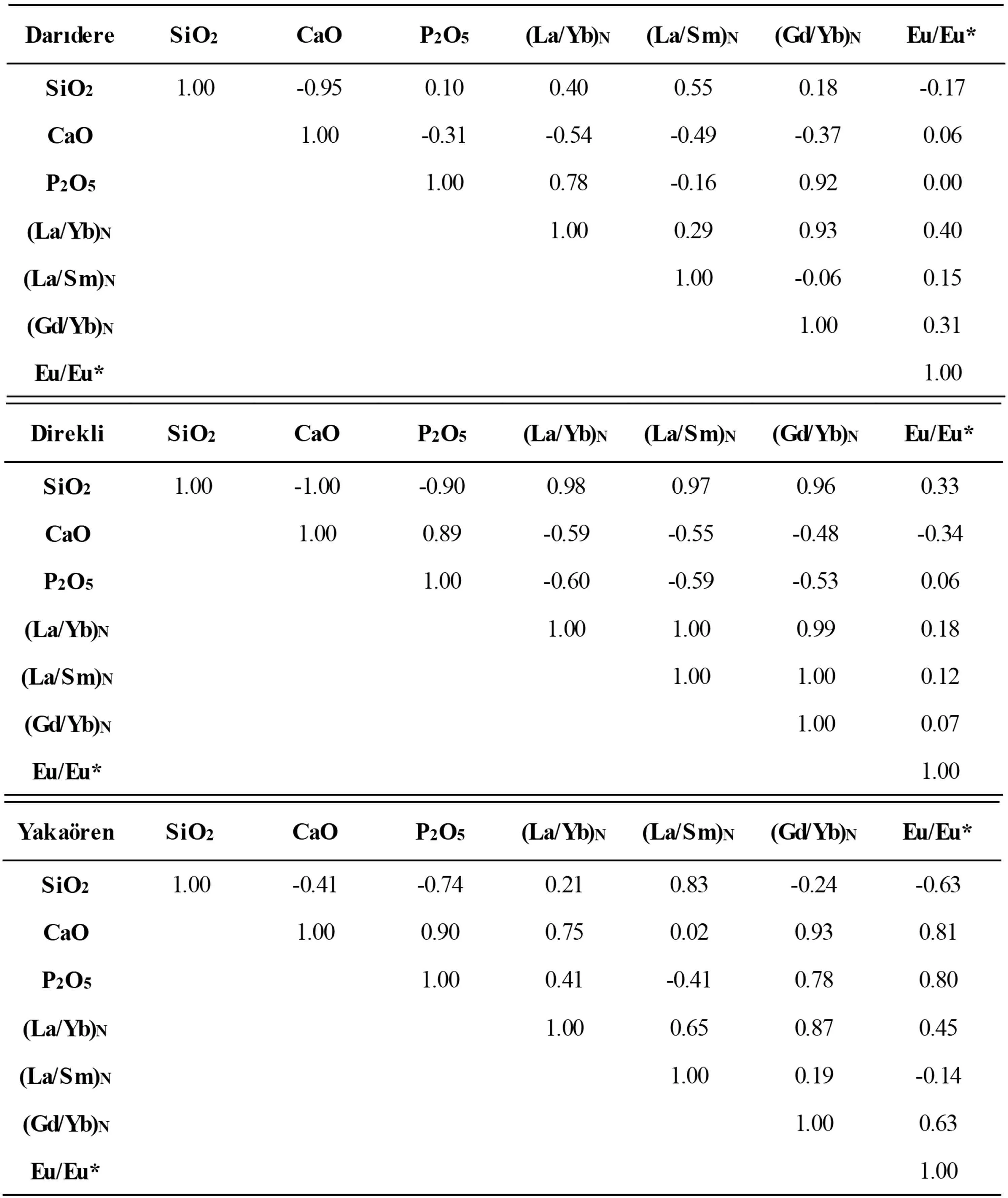
Table 4 Correlation coefficients of major elements (in wt.%), important ratios for Darıdere, Direkli and Yako¨ren regions
Overall, it should be specified that sharp distinction can not be observed between some of the correlations of elements and ratios, due to the extreme diversity of SiO2, CaO and LREE caused by episodal volcanic eruptions with different chemistry and involvement of sedimentary carbonates as well as Mg-rich silicate rocks.
The chondrite-normalized REE patterns of DDY deposits and Italian volcanics associated carbonatitic rocks are all characterized by a slightly concave-up shape and are parallel indicating post-collisional low silica alkaline magmatism and a metasomatised mantle source (Fig. 12).The concave-up patterns of compared pyroclastics would typically be interpreted as an amphibole control inherited from the source or primitive magma, reflecting the preference that amphibole is responsible for depletion MREE.In terms of the LREE enrichments including La, Ce, Pr elements, DDY values can be considered more promising than the Italian extrusive carbonatitic rocks (Fig. 12).Although Polino carbonatite dikes are likely to be more enriched in terms of the MREE, HREE values are higher in DDY deposits. In general, the LREE in orthopyroxene and HREE in clinopyroxene are more susceptible to subsolidus redistribution (Liang et al. 2021). Supporting this case, the HREE concentrations of DDY deposits are relatively similar to Cupaello carbonatite pyroclastics which having the HREE-bearing clinopyroxene minerals more abundant than other Italian extrusive carbonatitic rocks.
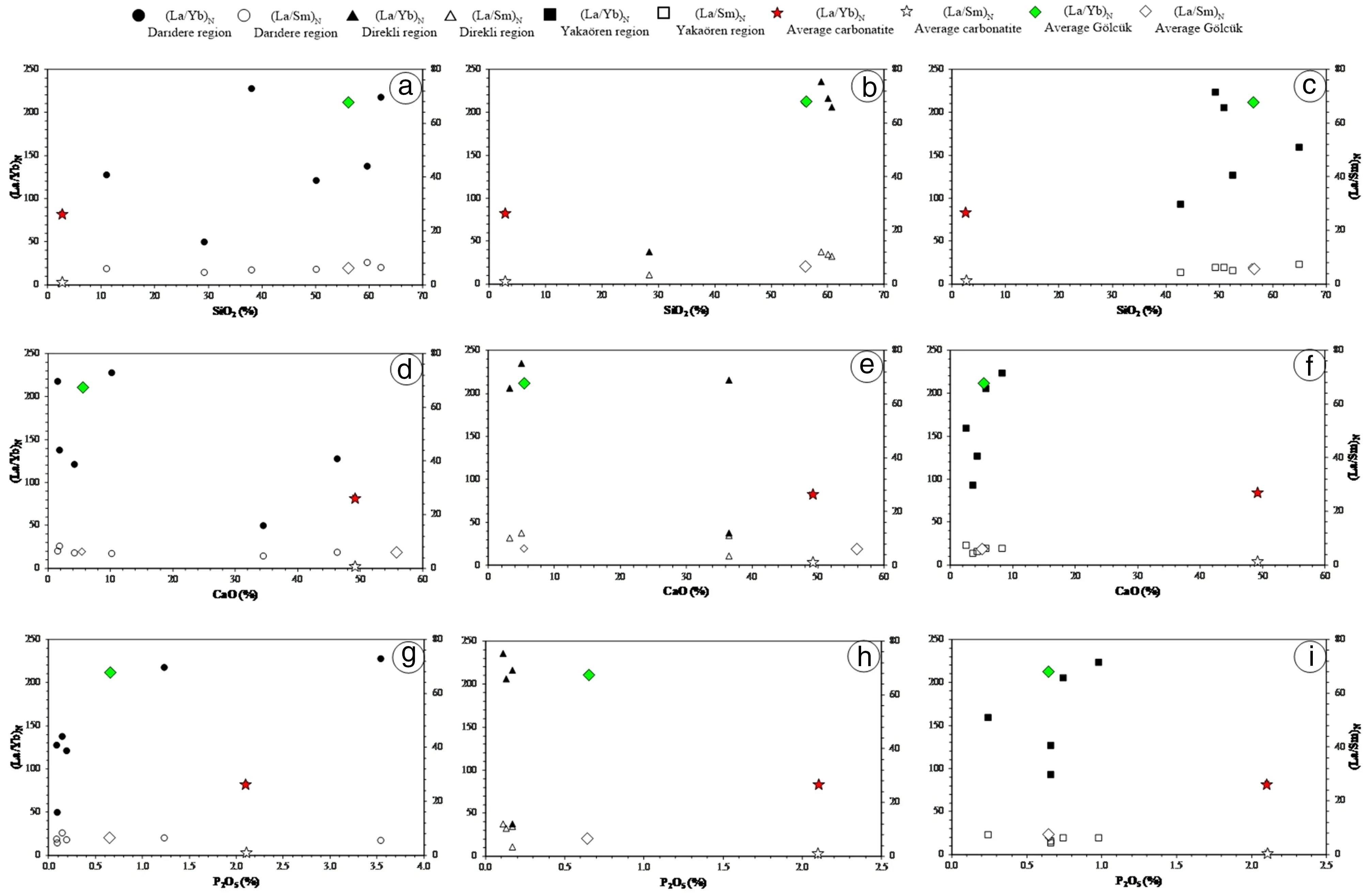
Fig. 10 Plots of a, b, c: SiO2 vs. (La/Yb)N vs. (La/Sm)N d, e, f: CaO vs. (La/Yb)N vs. (La/Sm)N g, h, i: P2O5 vs. (La/Yb)N vs. (La/Sm)N for Darıdere, Direkli and Yakao¨ren region, respectively. While the filled symbols show correlations of (La/Yb)N, open symbols indicate the (La/Sm)N correlations. The average carbonatite from Wolley and Kempe (1989) shown as the checked star
The negative anomalies of Rb, P, Ti and Zr are common in both Italian carbonatitic rocks and DDY deposits, indicating the same geochemical conditions and processes that have been active in magma chamber formation. The formation of Ti-bearing clinopyroxenes and Fe-Ti bearing oxides and Zr bearing minerals during earlier phases of fractional crystallization probably cause negative Ti and Zr anomalies (De Ignacio et al. 2012). The modal abundance of apatite minerals correlates the phosphor content and also responsible for some of the LREE concentrations. The positive anomalies of Pb, U and Th which were observed in DDY and Italian carbonatitic rocks indicate the involvement of pan-African meta-sedimentary basement rocks.
The Intraplate extrusive REE deposits show significant resemblance in terms of LREE and Eu patterns (Fig. 12).On the other hand, all Intraplate extrusive REE deposits have much higher HREE content probably caused by the higher intensity of the fractionation process during magma evolution (Fig. 12; Chandler and Spandler 2020). In addition, weathering process possibly helped the enrichments of HREE due to the longer exposure time to atmospheric events and the strong immobile behavior of such elements(Chandler and Spandler 2020). Other HFSE’s such as U,Th, Zr and Nb are also enriched because of increasing incompatible behavior in potassic-alkaline and undepleted initial magma sources (Fig. 12). In Toongi, Brockman,Foxtrot, and Round Top REE deposits, it can be concluded that hydrothermal solutions were also active which can be proven by the formation of fluorites, fluorcarbonates, Yxenotime, niobates and thorite minerals (Ramsden et al.1993; Taylor et al. 1995; Pingitore et al. 2014; Miller 2015;Spandler and Morris 2016). Negative Ba and Sr anomalies in Intraplate extrusive REE deposits indicate that the crustal contamination process negatively affected the Go¨lcu¨k and Italian extrusives in terms of ΣREE content.
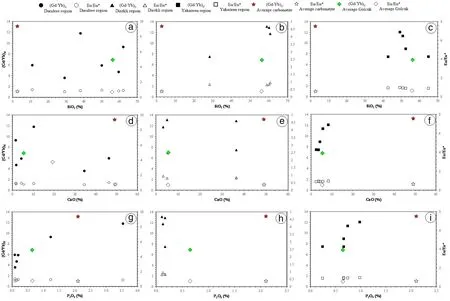
Fig. 11 Plots of a, b, c: SiO2 vs. (Gd/Yb)N vs. Eu/Eu* d, e, f: CaO vs. (Gd/Yb)N vs. Eu/Eu* g, h, i: P2O5 vs. (Gd/Yb)N vs. Eu/Eu* for Darıdere,Direkli and Yakao¨ren region, respectively. While the filled symbols show correlations of (Gd/Yb)N, open symbols indicate the Eu/Eu*correlations. The average carbonatite from Wolley and Kempe (1989) shown as the checked star
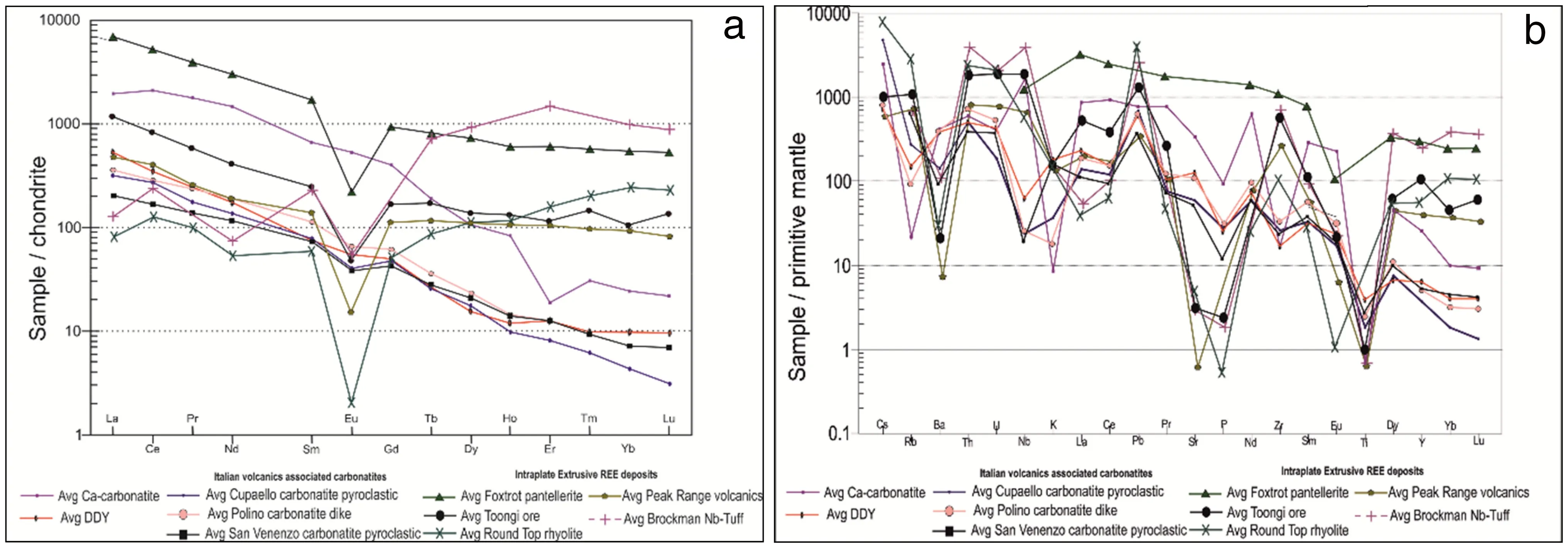
Fig. 12 a The chondrite-normalized (Boynton 1984) REE patterns b the mantle normalized trace element (Sun and McDonough 1989) patterns,of DDY deposit, Italian extrusive carbonatitic rocks (The average carbonatite from Wolley and Kempe (1989), the Italian volcanics patterns from Stoppa and Cundari (1995); Lupini et al. (1992); Stoppa and Wooley (1997)), Intraplate Extrusive REE deposit values were taken from; Ramsden et al. (1993); Price et al. (1990); Srivastava and Geo (2012); Spandler and Morris (2016); Chandler and Spandler (2020)
4.3 Economic implications
Although DDY deposits contain a significant amount of REE, they also need to be evaluated from an economic point of view. Since the 1960’s the deposits that met the global LREE demand are by far alkaline-carbonatite complexes. Therefore DDY deposits must be compared with some world-class REE deposits due to their geological features and economic importance.
Total REE values for DDY deposits are not high enough to compare with massive deposits such as Bayan Obo, Barra do Itapirapua˜, Toongi, and Foxtrot. However, some economic estimations have shown that the outlook for economic significance is also related to the proportion of critical elements in total REE (Seredin 2010). The offered formula by Seredin (2010) to calculate the outlook coefficient (Coutlook)of REE composition is; Coutlook= [(Nd + Eu + Tb + Dy+ Er + Y) / ΣREE)] / [(Ce + Ho + Tm + Yb + Lu) /ΣREE)]; %REEdef= Percentage of critical elements in total REE. Higher values of Outlook Coefficient (Coutlook)propose promising ores from the point of industry necessity.It has been proved that %REEdefand Coutlookvalues are also useful for phosphorite deposits, coal deposits, or different genetic types such as alkali and subalkali granite-related systems (Seredin and Dai 2012; Buccione et al. 2021). The cluster of DDY and linear expectations demonstrates that DDY deposit can be essential as well as Bayan Obo, Barra do Itapirapua˜, Italian carbonatites, Foxtrot and Toongi from the standpoint of promising critical REE (Fig. 13). The relatively high concentrations of Nd (ranging 15.8–193.4)and Y (ranging 13.3–61.7 ppm) caused promising Coutlookvalues for the DDY deposit. However, La (ranging 16.9-297.6 ppm) and Ce (ranging 25.4–457.3 ppm) constitute most of ΣREE values, therefore the economic importance of DDY deposits remains unclear with the current cut-off grade levels for the critical REEs such as Tb, Dy and Er.
According to the diagram shown in Fig. 13, it can be stated that DDY deposits (with a well-organized prospecting project) can gain economic importance with the help of increasing demand and tighter supply. Mainly DDY deposits are enriched in terms of LREE therefore it can be a competitor to most LREE deposits (such as Bayan Obo, Italian carbonatites and Toongi). The HREE (Y, Tb,Dy, Ho, Er, Tm, Yb and Lu) values are generally low which negatively affect the overall economic value of DDY deposits, compared to HREE enriched intraplate extrusive REE and ion adsorption type deposits.
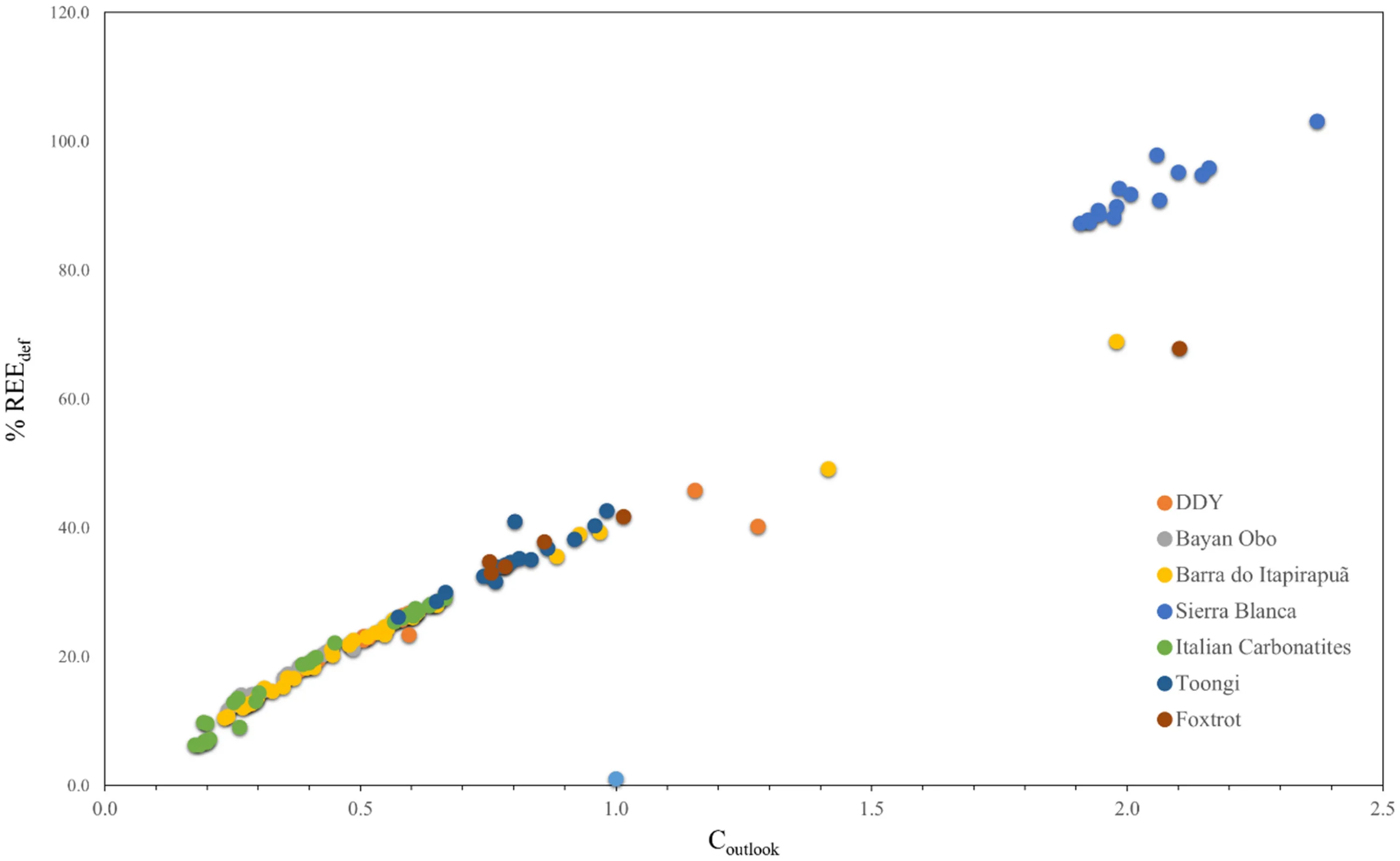
Fig. 13 Distribution of ore objects by outlook for individual REE %REEdef and Coutlook calculated by using formula of Seredin (2010)
5 Conclusion
In this study, the REE potential, geochemical and mineralogical characteristics surrounding REE-bearing minerals as well as formation modeling of unconsolidated pyroclastic flows in Darıdere-Direkli-Yakao¨ren (DDY) deposits in Turkey were revealed.
The volcanic rock fragments which are found in DDY deposits were defined as trachytes and trachyandesites with hyaloporphyritic textures. While trachyandesites are characteristic of abundant amphibole group minerals, the trachytes are dominated by clinopyroxene minerals. REEbearing minerals of DDY deposits were determined as apatite group minerals including fluorapatite and britholite,via XRD analysis conducted on mineral concentrate.Results on SEM–EDX studies showed that apatite and britholite are the main REE-bearing minerals as supported by XRD analysis, as well as chevkinite minerals are also found.
The DDY deposits which are located 7–13 km away from Go¨lcu¨k intra-caldera rocks are quite analogous in terms of the REE contents. According to geochemical analyses, the ΣREE content was determined up to 996 ppm in DDY samples. In terms of ΣREE values, Darıdere is the most enriched region followed by Yakao¨ren and Direkli regions. The enriching of denser minerals in the Darıdere region is probably caused by the movement of the ignimbiritic flow to the southeast direction. According to the comparison of the concentration variations of LREE,MREE and HREE, DDY samples are enriched with LREE,relative to MREE and HREE, with a total of 574.9, 38.5 and 5.28 ppm, respectively. The relationship between LREE and alkaline elements (Na and K) can be explained with the increasing incompatible behavior of the LREE in silica undersaturated, potassic magma evolution in subduction-related volcanic arcs. In addition, REE content in unlitified pyroclastics positively correlated with LILEs such as Ba, Sr and Rb, as well as P2O and can be interpreted as extracaldera volcanics. In particular, the enrichment of REE and HFSE such as U and Nb in pyroclastics shows that these elements are related to residual phases during fractional crystallization of magma and involvement of carbonate metasomatism during magma chamber formation.
All DDY samples contain sedimentary carbonate fragments, while the abundance of these carbonate fragments is relatively high in Darıdere and Direkli regions according to related correlation diagrams between CaO and chondrite normalized REE ratios. The scarcity of these sedimentary carbonate fragments in the Yakao¨ren region shed light on the carbonate metasomatism in the Go¨lcu¨k magma chamber. In addition, it was revealed that the increasing sedimentary carbonate involvement in DDY deposits negatively affects the REE concentrations.
DDY deposits and Italian extrusive carbonatitic rocks show quite similar characteristics, according to the chondrite normalized REE and mantle normalized trace element patterns, indicating that a series of homologous magmatic processes took place in the formation of both Italian extrusive carbonatitic rocks and DDY deposits. Moreover,the positive anomalies of Pb, U and Th which were observed in DDY deposits and Italian carbonatitic rocks indicated the involvement of pan-African meta-sedimentary basement rocks. While having similar La, Ce, Nd and Pr enrichment trends with the Intraplate extrusive REE deposits, DDY deposits does not have significant HREE,Nb and Zr contents. Such enrichments which can be found in deposits such as Brockman, Foxtrot and Round Top formed under the effect of higher levels of magmatic fractionation, weathering and recurrent hydrothermal activity. The relative absence of these factors resulted in a less economically promising deposit. However, the overall thickness of DDY deposits reaches nearly 200 m, therefore more mineralized zones can be found by a well-organized drilling project.
AcknowledgementsThis work was supported by the CAYDAG(1001) from the Scientific and Technological Research Council of Turkey (TUBITAK). Authors thank the team members of Geochemistry Research Laboratories of Istanbul Technical University(ITU/JAL) for their effort with geochemical analyses, as well as a Ph.D. student Sıddıka Mertdinc¸ for her efforts in SEM-EDX analysis.
Declarations
Conflict of interestThe authors declare that there is no conflict of interest.
杂志排行
Acta Geochimica的其它文章
- Interception, degradation and contributions of terrestrial organic carbon obtained from lignin analysis in Wujiang River, southwest China
- Mineralogy and geochemistry of fine-grained Dahab stream sediments,Southeastern Sinai,Egypt:emphasis on the intergrowths of Fe–Ti oxides
- Response of silicate chemical composition variation on thermal metamorphism of ordinary chondrites and classification of petrologic types: the case of L chondrites from Grove Mountains, Antarctica
- Hydrogeochemical characteristics and its role in controlling arsenic mobilization in a shallow aquifer
- Fluoride ions in groundwater of the Turkana County, Kenya, East Africa
- Distribution of functional microorganisms and its significance for iron, sulphur, and nitrogen cycles in reservoir sediments
